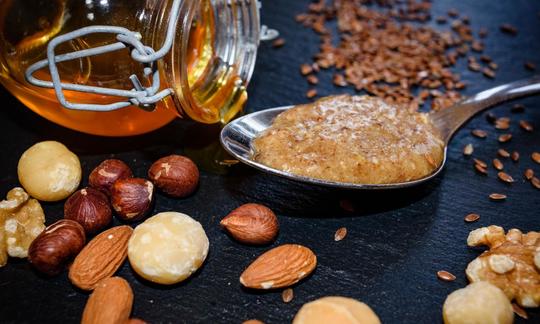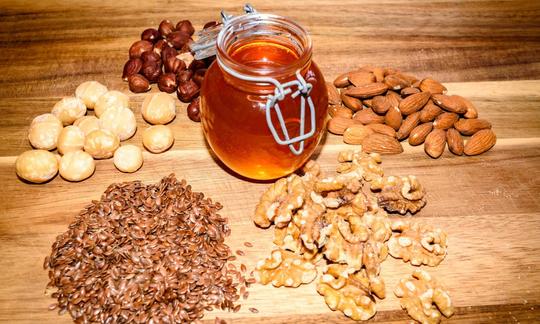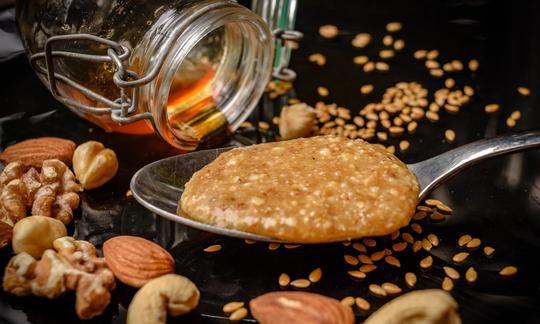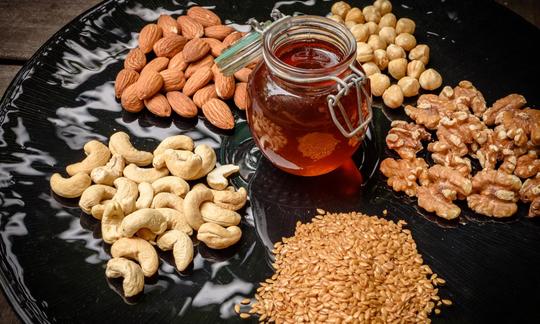Natura Sanat Honey Mix with Macadamia
raw-vegan
Ingredients (for servings, )
Equipment
- food processor
- coffee grinder, electric
Type of preparation
- chop or grind
- food preparation without heating
- blend
Preparation
Roughly chop the nuts in a suitable food processor. Finely grind the linseed together with some coarsely chopped nuts in an electric coffee grinder. We only add the latter to prevent the coffee grinder from getting clogged up by the linseed.
We found that the best device for chopping nuts is a powerful hand mixer (800 to 1000 watts).
Finely mix the coarsely chopped nuts using a suitable kitchen appliance, e.g. a hand blender.
An electric coffee grinder is also suitable here, but its small capacity makes a blender preferable.
Mix the chopped ingredients together, stir in the honey with a spoon and store in a sealable jar.
Due to the antibiotic effects of the honey, the mixture can also be kept at room temperature, but the unsaturated fatty acids in the linseed and walnuts can develop a rancid aftertaste over time due to too much contact with air. We therefore recommend storing it in a well-sealable container. This means that the mixture can be enjoyed for 3-4 weeks without any loss of taste.
|
Nutritional Information per person
Convert per 100g
|
2000 kcal | |
|---|---|---|
| Energy | 77 kcal | 3.9% |
| Fat/Lipids | 4.9 g | 7.0% |
| Saturated Fats | 0.50 g | 2.5% |
| Carbohydrates (inc.dietary fiber) | 8.4 g | 3.1% |
| Sugars | 7.1 g | 7.9% |
| Fiber | 1.1 g | 4.4% |
| Protein/Albumin | 1.3 g | 2.6% |
| Cooking Salt (Na:1.0 mg) | 2.5 mg | 0.1% |
| Essential micronutrients with the highest proportions | per person | 2000 kcal | |
|---|---|---|---|
| Fat | Alpha-Linolenic acid; ALA; 18:3 omega-3 | 0.54 g | 27.0% |
| Min | Manganese, Mn | 0.31 mg | 16.0% |
| Min | Copper, Cu | 0.11 mg | 11.0% |
| Fat | Linoleic acid; LA; 18:2 omega-6 | 1.1 g | 11.0% |
| Vit | Thiamine (vitamin B1) | 0.07 mg | 6.0% |
| Prot | Tryptophan (Trp, W) | 0.02 g | 6.0% |
| Vit | Vitamin E, as a-TEs | 0.70 mg | 6.0% |
| Elem | Magnesium, Mg | 19 mg | 5.0% |
| Elem | Phosphorus, P | 33 mg | 5.0% |
| Prot | Threonine (Thr, T) | 0.05 g | 5.0% |
Detailed Nutritional Information per Person for this Recipe
The majority of the nutritional information comes from the USDA (US Department of Agriculture). This means that the information for natural products is often incomplete or only given within broader categories, whereas in most cases products made from these have more complete information displayed.
If we take flaxseed, for example, the important essential amino acid ALA (omega-3) is only included in an overarching category whereas for flaxseed oil ALA is listed specifically. In time, we will be able to change this, but it will require a lot of work. An “i” appears behind ingredients that have been adjusted and an explanation appears when you hover over this symbol.
For Erb Muesli, the original calculations resulted in 48 % of the daily requirement of ALA — but with the correction, we see that the muesli actually covers >100 % of the necessary recommendation for the omega-3 fatty acid ALA. Our goal is to eventually be able to compare the nutritional value of our recipes with those that are used in conventional western lifestyles.
| Essential fatty acids | per person | 2000 kcal |
|---|---|---|
| Alpha-Linolenic acid; ALA; 18:3 omega-3 | 0.54 g | 27.0% |
| Linoleic acid; LA; 18:2 omega-6 | 1.1 g | 11.0% |
| Essential amino acids | per person | 2000 kcal |
|---|---|---|
| Tryptophan (Trp, W) | 0.02 g | 6.0% |
| Threonine (Thr, T) | 0.05 g | 5.0% |
| Phenylalanine (Phe, F) | 0.07 g | 5.0% |
| Isoleucine (Ile, I) | 0.05 g | 4.0% |
| Leucine (Leu, L) | 0.09 g | 4.0% |
| Valine (Val, V) | 0.06 g | 4.0% |
| Lysine (Lys, K) | 0.04 g | 2.0% |
| Methionine (Met, M) | 0.02 g | 2.0% |
| Vitamins | per person | 2000 kcal |
|---|---|---|
| Thiamine (vitamin B1) | 0.07 mg | 6.0% |
| Vitamin E, as a-TEs | 0.70 mg | 6.0% |
| Biotin (ex vitamin B7, H) | 1.9 µg | 4.0% |
| Vitamin B6 (pyridoxine) | 0.04 mg | 3.0% |
| Folate, as the active form of folic acid (née vitamin B9 and | 6.0 µg | 3.0% |
| Riboflavin (vitamin B2) | 0.03 mg | 2.0% |
| Niacin (née vitamin B3) | 0.21 mg | 1.0% |
| Pantothenic acid (vitamin B5) | 0.07 mg | 1.0% |
| Vitamin C (ascorbic acid) | 0.20 mg | < 0.1% |
| Vitamin A, as RAE | 0.03 µg | < 0.1% |
| Vitamin K | 0.35 µg | < 0.1% |
| Essential macroelements (macronutrients) | per person | 2000 kcal |
|---|---|---|
| Magnesium, Mg | 19 mg | 5.0% |
| Phosphorus, P | 33 mg | 5.0% |
| Potassium, K | 55 mg | 3.0% |
| Calcium, Ca | 14 mg | 2.0% |
| Sodium, Na | 0.97 mg | < 0.1% |
| Essential trace elements (micronutrients) | per person | 2000 kcal |
|---|---|---|
| Manganese, Mn | 0.31 mg | 16.0% |
| Copper, Cu | 0.11 mg | 11.0% |
| Iron, Fe | 0.38 mg | 3.0% |
| Zinc, Zn | 0.26 mg | 3.0% |
| Selenium, Se | 0.74 µg | 1.0% |
| Fluorine, F | 0.58 µg | < 0.1% |
| Iod, I (Jod, J) | 0.10 µg | < 0.1% |
I got the original recipe from the ophthalmologist Dejan Momirov. However, the raw version of the Natura Sanat honey mix contains macadamia instead of cashews to maintain a healthy ratio of omega fatty acids. Honey serves as a natural preservative. " Natura Sanat " is part of the phrase "medicus curat, natura sanat" (The doctor treats, nature heals) and is based on the Greek doctor Hippocrates.
Serving size: We have set the serving size at 30. This corresponds to about one month for one person at an amount of about 3 teaspoons per day (14-18g).
Nutrient profile: According to GDA guidelines, one portion (≈ 3 tsp) covers approximately ¼ of the daily requirement of essential alpha-linolenic acid (ALA) and has a very good ratio of omega-6 to omega-3 fatty acids of 2:1.
Flaxseeds: These have a slightly nutty taste and have a fat content of around 40%. More than half of this consists of alpha-linolenic acid (ALA), a polyunsaturated omega-3 fatty acid. Therefore, linseed oil has the highest omega-3 fatty acid concentration of all known vegetable oils. This makes up for the deficiencies in this area of almonds and hazelnuts.
Walnuts: Of all known nuts, walnuts have the best ratio of omega-6 to omega-3 alpha-linolenic acid (ALA). They also have health benefits thanks to tocopherols (forms of vitamin E) and many macro and trace elements.
Almonds: Sweet almonds are ideal as a snack, in muesli ( pea muesli), or as a topping for salads. Sweet almonds contain relatively high levels of vitamin E and vitamin B2 (riboflavin) and, like other nuts, are rich in manganese.
Hazelnuts: Hazelnuts have a high fat content (over 60%), of which 75% is unfortunately monounsaturated oleic acid. This is also clearly evident in hazelnut oil, which, along with olive oil, has one of the highest oleic acid contents.
Macadamia nuts: Due to their fine aroma, macadamia nuts are one of the tastiest nuts in the world. They contain many minerals and B vitamins. Omega-6 to Omega-3 fatty acids are in a relatively good ratio of 6:1.
Bee honey: We use real bee honey in this recipe. This is raw if it is produced by cold spinning. During storage and processing, temperatures above 42 °C lead to a reduction in temperature-sensitive ingredients. Very strict vegans, however, avoid honey. You can find more information under the ingredient honey.
Shelf life: In our experience, this recipe retains its taste even after about a month if stored properly.
Cashew nuts: As an alternative to macadamia nuts, you can use cheaper cashews in the same proportions. However, cashew nuts sold in stores are either pre-treated with steam or roasted to deactivate the toxic oil cardol. So they are usually not raw in the true sense of the word. If it says "raw cashew nuts" on the package, this usually only indicates that the toxic cardol was deactivated using steam rather than a roasting process. In addition, they have a very poor ratio of omega-6 to omega-3 fatty acids at 48:1.
More information and tips on common nutritional mistakes made by vegans and raw foodists can be found at the following link: Vegans often eat unhealthily. Avoidable nutritional errors.










